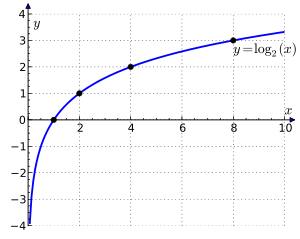Logarithms
The graph of the logarithm to base 2 crosses the x axis (horizontal axis) at 1 and passes through the points with coordinates (2, 1), (4, 2), and (8, 3). For example, log2(8) = 3, because 2^3 = 8. The graph gets arbitrarily close to the y axis, but does not meet or intersect it.
The logarithm of a number is the exponent by which another fixed value, the base, has to be raised to produce that number. For example, the logarithm of 1000 to base 10 is 3, because 1000 is 10 to the power 3: 1000 = 10^3 = 10 × 10 × 10. More generally, if x = by, then y is the logarithm of x to base b, and is written logb(x), so log10(1000) = 3.
Logarithms were introduced by John Napier in the early 17th century as a means to simplify calculations. They were rapidly adopted by scientists, engineers, and others to perform computations more easily and rapidly, using slide rules and logarithm tables. These devices rely on the fact—important in its own right—that the logarithm of a product is the sum of the logarithms of the factors:
{Log (ab) = Log a + Log b} (1st law of logarithms)
Wikipedia
Googles
Wolfram


Comments
Post a Comment